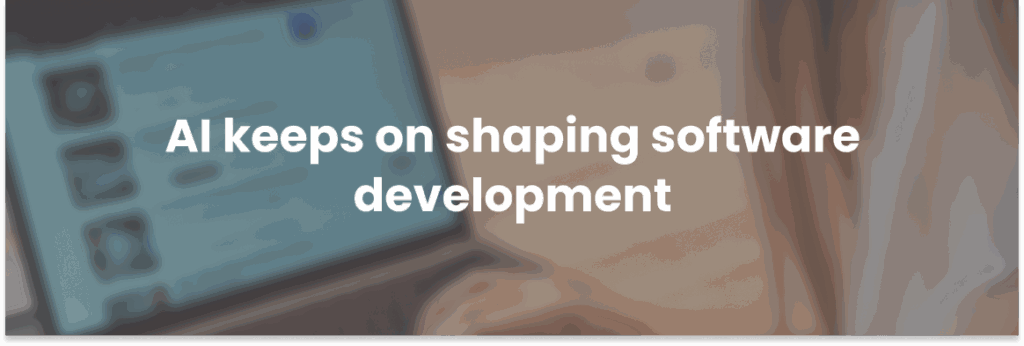AI Power Tools for Software Development: the 3 quick hacks
AI 101: It is focused on building systems that can perform tasks that normally require human intelligence. These tasks, in general terms, include:
- Recognizing images and faces.
- Translating languages.
- Understanding language and speech.
But, when we dive into coding… the scope amplifies in unimaginable ways.
Modern AI mostly uses machine learning, where systems learn patterns from data instead of being programmed with fixed rules.
But there’s more to it. A more advanced form, called deep learning, uses neural networks inspired by how the human brain works to emulate cognitive processes.
Spot the difference
| MACHINE LEARNING | DIFFERENCE | DEEP LEARNING |
| From data using algorithms to perform a task without being explicitly programmed | The Learning | From a complex structure of algorithms modeled on the human brain |
| Linear Regressions, clustering algorithms and decision trees. | It uses | Artificial Neural Network (ANN) |
| Analytics and statistics | Inspiration | Human Brain |
| Chatbots, Dynamic pricing, Language transaltion. | Used in | NLP, Automated driving, Military, Tech industry. |
| Feature interaction from a human to make decisions. And, from deep learning 👑 *It’s part of machine learning. | Requires | Vast amount of data, but much less human interaction. It learns. |
| Integration with blockchain and IoT | Latest development | Transfer Learning |
This innovative advances broaden ALL areas of knowledge scope; engineering and software development play a crucial role from within and the impact.

AI continues to shape software development because it fundamentally enhances how software is created, tested, deployed, and maintained.
It accelerates innovation, creativity, and also reduces costs and time. They work hand in hand, not just technically, but structurally, strategically, and evolutionarily. Three key terms to bear in mind!
AI can not work by itself, to be useful in the world, it needs to be embedded into software systems and a human touch!
Integrating AI into mobile apps, desktop applications, web platforms is the 2025 task that has everyone’s hands on deck.
Also, running AI in production involves classic software practices from the backend and frontend sides, here you can check some tools.
Latest tools to use
The realm of software development, content creation, and productivity enhancement is being revolutionized by AI.
There are a variety of tools available nowadays, assisting with tasks ranging from programming to producing visuals and videos, allowing experts to operate at a quicker pace, with greater creativity, and enhanced efficiency.
Here are several leading AI tools that are currently influencing the industry:
- Amazon CodeWhisperer
Amazon’s AI coding assistant offers real-time code suggestions and recommendations based on existing inputs. It supports natural language-to-bash translation and is available for JetBrains and Visual Studio IDEs. - Cursor AI
This AI provides autocomplete suggestions across multiple lines of code and offers a smart rewrite function to correct typos and syntax errors. It also features a chatbot assistant that can answer questions about the active file or specific code blocks. - GrammarlyGO
GrammarlyGO is an AI powered content creation tool that allows users to brainstorm ideas, create outlines, draft, and repurpose past work. It enhances writing by suggesting modifications and ensuring clarity and tone. A great tool for Frontend Developers and UX/UI!

From market research and feature identification to interface creation, AI accelerates processes and enhances decision-making.
During the development phase, it enables code generation and refinement, error detection, and test automation. It also facilitates intelligent monitoring during production and the analysis of user behavior after the product launch. A must-shine for clients!
Additionally, it can be integrated into client-facing solutions through features like chatbots, recommendations, or personalization, adding greater value to the final products; some more examples:
Code Generation & Refactoring
- ChatGPT Code Assistant: Speeds up writing boilerplate and repetitive logic in both frontend (React, Next.js) and backend (Rails, Node).
- Automated refactoring: Tools like Codiga or Sorcery help improve code quality automatically.
Code Reviews
- Linting and quality checks: AI-powered static code analysis tools (e.g. DeepSource, Codacy) flag issues faster than manual reviews.
- Automated test case suggestions: Based on changed code, AI can recommend or generate test cases.
Bug Detection & Fixing
- AI can scan logs and predict causes of errors or suggest fixes (Sentry + AI assistants, or Rookout with GPT).
UX/UI design
- UI generation: Tools like Uizard, Galileo AI, or Figma AI plugins generate mockups from text descriptions.
- User flow optimization: AI can analyze usage patterns to suggest improvements in navigation or interaction design.
- Accessibility audits: AI tools can assess designs for WCAG compliance.
Through the incorporation of AI, companies have the opportunity to lower expenses, expedite their time to market, and provide offerings that more effectively align with consumer demands all while maintaining their edge in rapidly evolving markets.
Rounding up
We shared in our previous post how AI has transformed the way we live, presenting new opportunities and also ethical dilemmas.
Now we brought some down-to-earth examples for you to dive into machine learning and deep learning!
Keep yourself posted and subscribe, we’re utterly convinced that this topic will be in the limelight for quite some time!
As technology evolves to become more intelligent, flexible, and focused on user needs, AI will remain integral to our processes of creating, enhancing, and utilizing digital products.
Welcoming AI isn’t merely a matter of staying relevant; it’s about spearheading advancements in a landscape characterized by continuous innovation.

